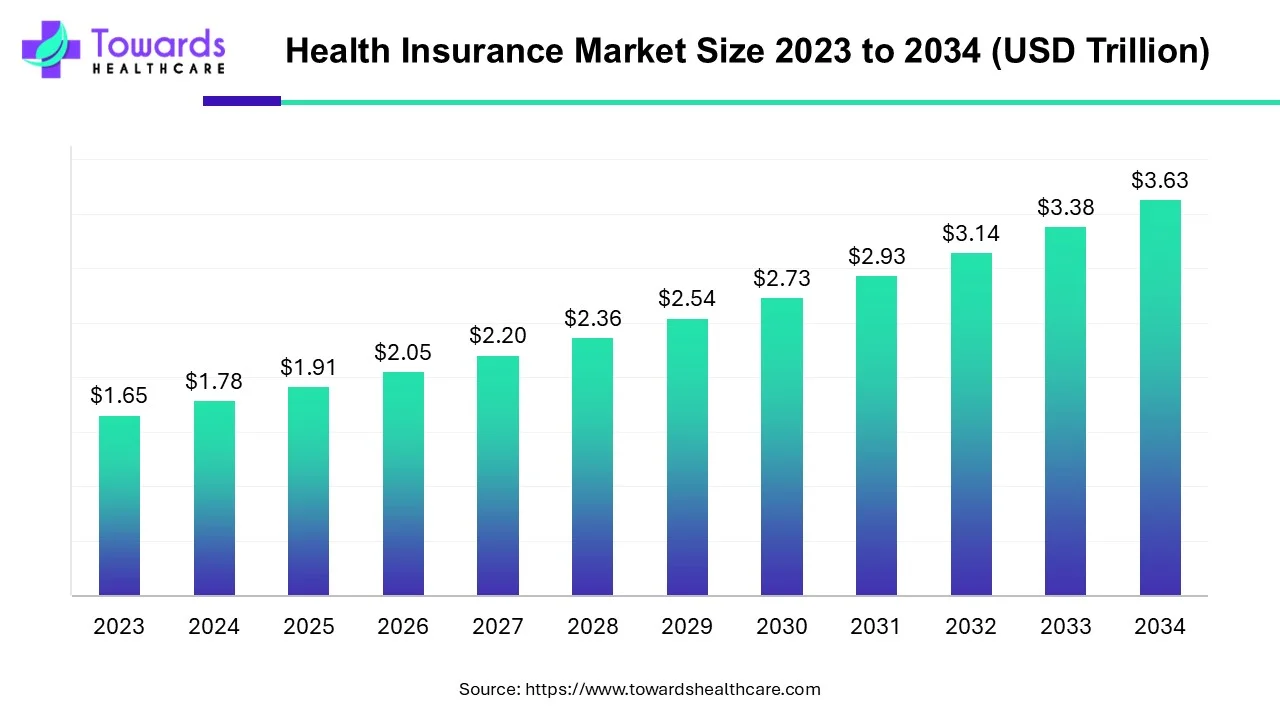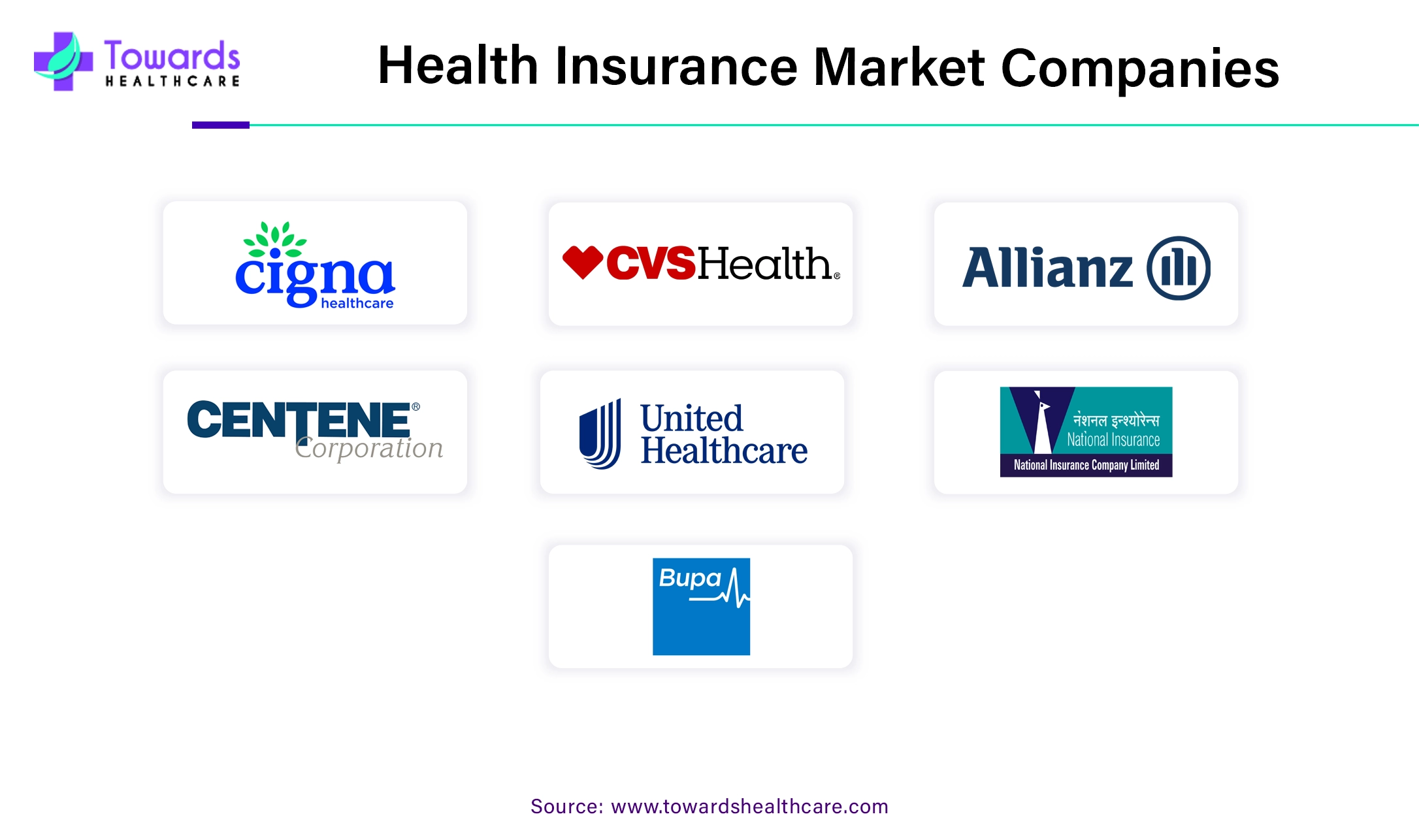March 2025


Principal Consultant

Reviewed By
The global health insurance market size is calculated at USD 1.78 trillion in 2024 and is expected to be worth USD 3.63 trillion by 2034, expanding at a CAGR of 7.4% from 2024 to 2034, as a result of the rising healthcare expenditure and extensive coverage benefits against multiple medical conditions.

According to the American Community Survey (ACS) 1-year estimates, twenty-seven states had a greater percentage of individuals with health insurance coverage in 2022 than in 2021. From 2021 to 2022, 13 states reported improvements in public coverage, with only Rhode Island reporting a 2.2 percentage point reduction.
As one of the main tools for attaining social equity in the healthcare structure, health insurance promotes access to essential medicines and healthcare services, protecting people's fundamental rights to life and reaching universal health goals. By actively encouraging the use of pharmaceuticals and medical services, health insurance directly impacts pharmaceutical sector investment and stimulates innovation. Health insurance is critical for pharmaceutical modernization by ensuring access to required pharmaceuticals. Pharmaceutical innovation refers to discovering and developing novel medicines through preclinical testing, clinical trials, scientific research, and drug design.
Understanding disease molecular pathways, finding possible therapeutic targets, and generating new chemical entities capable of treating, preventing, or managing various diseases are all part of the process. By providing patients with greater efficacy as well as safer treatment alternatives and allowing healthcare systems to provide individualized and cost-efficient care, pharmaceutical innovation improves the overall efficiency of health insurance systems and population health outcomes. It lowers financial obstacles and encourages pharmaceutical businesses to invest in research and development. Health insurance effectively bridges the gap between affordability and medical discoveries, producing a dynamic market that encourages innovation.
For Instance,
 Changes in health insurance significantly impact patients, payers, and providers. From the patient and payer’s standpoint, a higher health insurance concentration may diminish health plan options and increase premiums. For providers, this can potentially erode bargaining power reimbursement negotiations and limit anatomy in practice; understanding how health insurers respond to market pressure and influence premiums has become a crucial aspect of the U.S. healthcare sector.
Changes in health insurance significantly impact patients, payers, and providers. From the patient and payer’s standpoint, a higher health insurance concentration may diminish health plan options and increase premiums. For providers, this can potentially erode bargaining power reimbursement negotiations and limit anatomy in practice; understanding how health insurers respond to market pressure and influence premiums has become a crucial aspect of the U.S. healthcare sector.
The evolution of the market, influenced by these factors, has seen a notable increase. Insurer dynamics, market forces, and regulatory changes have led to a more complex landscape. Policymakers, recognizing the need for additional evidence, have called for comprehensive studies. In response to such calls, a recent study revealed that 57% of U.S. metropolitan statistical areas were experiencing notable shifts in their healthcare markets, further emphasizing the importance of ongoing research and analysis in this dynamic field.
Artificial Intelligence (AI) is poised to significantly transform the health insurance market by driving growth and improving efficiency. AI technologies, including machine learning and natural language processing, offer innovative solutions to enhance customer experience and streamline operations. AI-powered chatbots and virtual assistants provide personalized customer service and support, improving user engagement and satisfaction. They can handle a wide range of queries, from policy information to claims processing, reducing the need for human intervention and cutting operational costs.
In addition, AI algorithms can analyze vast amounts of data to identify patterns and trends, enabling insurers to better assess risk and set premiums more accurately. Predictive analytics can forecast future health trends and patient needs, allowing for more proactive and preventive care management. Fraud detection is another crucial area where AI excels, identifying unusual claims and potential fraud with greater accuracy.
Furthermore, AI-driven automation of administrative tasks can reduce processing times and errors, leading to faster claims approval and improved operational efficiency. Overall, the integration of AI in the health insurance market promises not only to enhance customer experiences but also to drive market growth through increased efficiency and more informed decision-making.
The rising costs of surgeries, hospital stays, and medical services have caused a global financial crisis. Health insurance provides critical financial assistance in the event of a severe illness or accident. Surgical expenses, doctor fees, hospitalization costs, emergency room charges, and diagnostic testing fees are all included in the cost of medical services. The rising cost of medical services has fueled the expansion of the health insurance market.
For Instance,

The rising cost of medical services is a global concern, driven by factors such as advanced technologies, increasing demand for healthcare, and rising pharmaceutical expenses. This trend puts pressure on the healthcare insurance market as they strive to cover these expensive services. As medical costs rise, healthcare insurance premiums often increase to accommodate these expenses. Insurance providers face the challenge of balancing coverage affordability for policyholders while ensuring they can meet the financial demands of expensive medical treatments and procedures.
This delicate equilibrium is crucial to sustaining a viable healthcare insurance market. The impact on the expanding healthcare insurance market includes potential barriers to access for individuals without coverage due to rising premiums. Additionally, insurers may adopt strategies such as adjusting coverage terms, implementing cost-sharing measures, or exploring innovative models to manage expenses. Policymakers play a role in addressing these challenges through regulations, subsidies, and initiatives to promote cost-effective healthcare delivery.
In conclusion, the escalating cost of medical services significantly impacts the expanding healthcare insurance market, influencing premiums, coverage terms, and access to care. Effective solutions require a balance between providing comprehensive coverage and managing the financial sustainability of insurance programs.
The need for more awareness regarding healthcare insurance significantly restrains the market's growth in several ways. Limited awareness means a lower demand for insurance products, as individuals may need to fully understand the benefits or underestimate the importance of health coverage. This leads to a smaller customer base and reduced market expansion; inadequate awareness contributes to a lack of understanding about the diverse range of insurance plans available, preventing potential policyholders from making informed decisions. This hampers market growth as consumers may need help finding suitable plans tailored to their needs, further dampening overall demand.
Additionally, the lack of awareness can result in delayed or foregone preventive healthcare measures. Individuals may need to be aware of the advantages of regular check-ups and early intervention, potentially leading to higher healthcare costs in the long run. This impacts the insurance market by increasing the prevalence of more expensive and severe health issues, negatively affecting insurers and policyholders.
Furthermore, a lack of awareness may contribute to scepticism about the value of healthcare insurance, with individuals questioning the necessity of paying premiums. This scepticism can create a barrier to market entry for insurance providers and hinder the development of a robust and competitive insurance landscape.
Addressing this issue requires targeted education campaigns to raise awareness about the benefits of healthcare insurance, the range of available plans, and the importance of proactive healthcare management. Increased awareness expands the market by attracting more customers and fosters a healthier and more financially sustainable healthcare system.
InsurTechs in the United States have benefited from a rich and competitive VC funding market, and many insurance start-ups have successfully completed some funding rounds. However, in markets with no strong VC culture, the approach to raising capital will be different, with public sources becoming more important.
For Instance,
Algorithms, artificial intelligence (AI), and robo-advice AI refers to machine intelligence. A machine is deemed "intelligent" when it evaluates its surroundings and takes action to maximize its chances of reaching its stated goal. It is commonly utilized for developing computer programs with cognitive characteristics such as learning and problem solving. AI research is being conducted in areas like as reasoning, knowledge, planning, learning, natural language processing, perception, and object movement/manipulation.
Innovation and technologies in the healthcare insurance market create synergy beyond traditional insurer-provider relationships. They enable value co-creation, leading to more comprehensive, efficient, and consumer-centric healthcare insurance solutions.
Medical insurance is a safety net, covering a substantial portion of individuals' healthcare expenses. This financial security encourages people to seek necessary medical services without fearing high out-of-pocket costs. By mitigating financial risks associated with healthcare, insurance companies instil confidence among policyholders, thereby supporting expanding the healthcare insurance market. Many medical insurance plans include preventive services like vaccinations, screenings, and wellness programs. These initiatives aim to detect and address health issues early, promoting overall well-being.
The emphasis on preventive care enhances individual health and contributes to long-term cost savings for both policyholders and insurance providers, fostering sustainability in the healthcare insurance market. Medical insurance enhances the accessibility of healthcare services for a broader segment of the population. Individuals with insurance coverage are more likely to seek timely medical assistance, preventing the progression of illnesses and reducing strain on healthcare resources. Improved access to healthcare services leads to increased demand for insurance products, driving market growth as more people recognize the value of coverage.
Insurance plans often come with a network of healthcare providers, ensuring that policyholders can access various medical professionals and facilities. This promotes the delivery of quality healthcare services. The collaboration between insurance companies and healthcare providers establishes a symbiotic relationship, with insurers incentivizing providers to deliver efficient and effective care. This collaboration enhances the overall quality of healthcare services in the market. The demand for medical insurance stimulates innovation within the insurance market. Insurers differentiate themselves by offering unique coverage options, personalized plans, and technological solutions to enhance the customer experience.
Intense competition among insurance providers fosters market growth as companies continually strive to improve their offerings and attract a more extensive customer base. In summary, medical insurance acts as a catalyst for the growth of the healthcare insurance market by addressing financial concerns, promoting preventive care, enhancing accessibility, fostering quality healthcare, and driving innovation and competition within the industry.
By provider, the public segment held a dominant presence in the market in 2023. Public health insurance providers include a system that provides universal health coverage by local governments or central governments of the respective countries. It is estimated that $8 per person on average was spent on health by governments in low-income countries in 2023. The segment’s growth is driven by increased public trust in government policies and suitable regulatory frameworks.
By provider, the private segment is expected to grow at the fastest rate in the market during the forecast period. The demand for private health insurance providers increases due to enhanced services, implementation of technological advances, and tailored benefits.
By coverage, the lifetime coverage segment dominated the market in 2023. Lifetime coverage helps to renew insurance coverage without re-qualifying for a new policy, thereby reducing the time to apply for a new policy and the costs associated with re-applying. It is most widely preferred as it provides financial security throughout life and ensures uninterrupted access to mediclaim coverage, irrespective of age or health conditions.
By coverage, the term insurance segment is anticipated to grow with the highest CAGR in the market during the studied years. Term insurance offers financial security to the entire family in case of the death of the policyholder. It offers a high sum at an affordable premium. Additionally, it offers additional coverage for critical illnesses or accidental death. These benefits eventually augment the segment’s growth.
By network provider, the preferred provider organization held a dominant presence in the health insurance market in 2023. A preferred provider organization (PPO) is a medicare arrangement in which medical services are provided at a much lower cost than in the plan. It negotiates fees and schedules for services with healthcare professionals and facilities. Participants can choose from a wide range of services from any provider from their network.
By network provider, the point of sale segment will witness a lucrative growth of the market over the studied period. A point of sale (POS) is a managed-care health insurance plan that provides different benefits for using in-network and out-of-network providers. POS plans are cost-effective compared to the high premium of PPO. The products of POS are pre-underwritten, i.e. the terms and conditions are predetermined by the insurance company.
In 2022, North America dominated the world market for health insurance. This segment has grown due to North America's higher health insurance penetration rate. In North America, healthcare expenditures and costs are incredibly high. Most people rely on their medical insurance to pay for their treatments. In addition, a significant market like the United States has a very high prevalence of chronic diseases.
An estimated 60% of Americans are thought to be afflicted with one or more chronic illnesses. The primary causes of the high cost of healthcare are the availability of sophisticated infrastructure for healthcare and easier access to these facilities. The primary drivers of the health healthcare market's explosive expansion are the region's high literacy rate and the general public's growing awareness of the advantages of insurance policies.

Asia-Pacific is anticipated to grow at the fastest rate during the projected period. The world's population is concentrated in the Asia Pacific region. The insurance industry's increasing penetration and quick urbanization expand the market. The leading causes of the region's rising chronic disease prevalence are changing consumer lifestyles, poor eating habits, and an increase in obesity. The most notable factors that are anticipated to propel the growth of the Pacific region of Asia health insurance market in the upcoming years are rising disposable income, expanding internet access, rising level of literacy, increasing investments in the construction of cutting-edge healthcare infrastructure, and growing public awareness of health insurance.
For Instance,
Companies investing in innovative healthcare solutions contribute to industry growth, as their advancements create new opportunities and increase the overall demand for healthcare insurance from emerging Tech firms and collaborations with healthcare providers. As technological advancements continue, companies are exploring data analytics, telemedicine integration, and personalized coverage options to gain a competitive edge. Regulatory compliance, customer experience, and strategic partnerships also play pivotal roles in shaping the dynamics of the healthcare insurance sector.
G. Srinivasan, MD and CEO of Galaxy Health announced that the company plans to become a significant health insurance player in India in the next 2-3 years and aims to launch at least one product per month. He also shared that the company aims to use technology to enhance efficiency, improve customer connections, and elevate the level of service provided.

By Provider
By Coverage Type
By Network Provider
By Plan Type
By Level of Plan Coverage
By Age Group
By Distribution Channel
By Geography
March 2025
March 2025
March 2025
March 2025